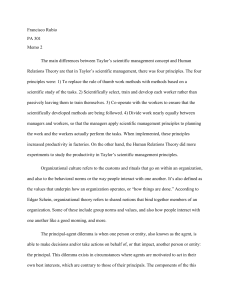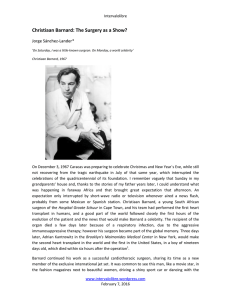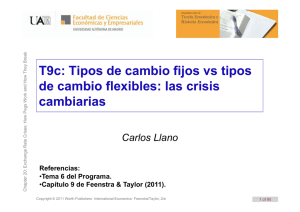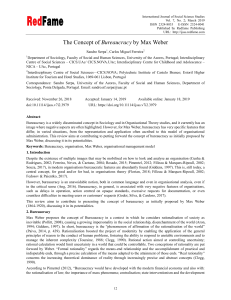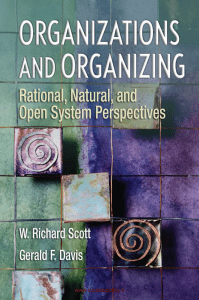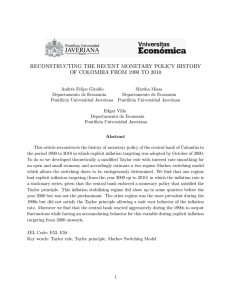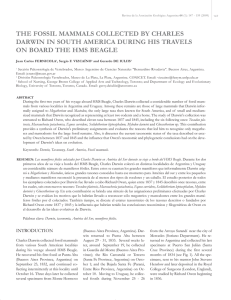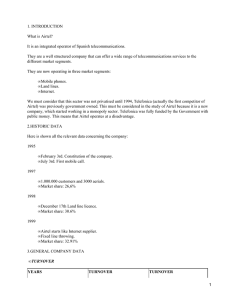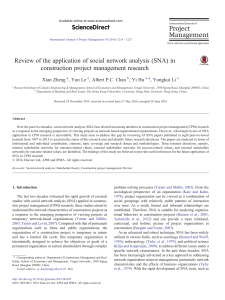Contemporary management practices
Anuncio
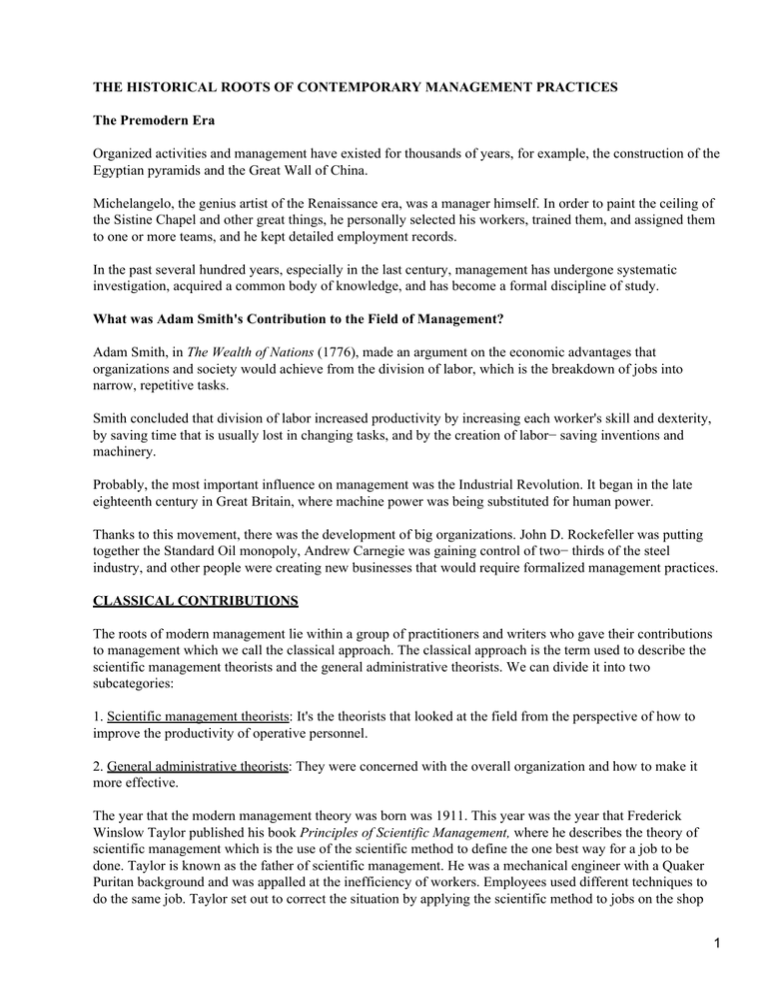
THE HISTORICAL ROOTS OF CONTEMPORARY MANAGEMENT PRACTICES The Premodern Era Organized activities and management have existed for thousands of years, for example, the construction of the Egyptian pyramids and the Great Wall of China. Michelangelo, the genius artist of the Renaissance era, was a manager himself. In order to paint the ceiling of the Sistine Chapel and other great things, he personally selected his workers, trained them, and assigned them to one or more teams, and he kept detailed employment records. In the past several hundred years, especially in the last century, management has undergone systematic investigation, acquired a common body of knowledge, and has become a formal discipline of study. What was Adam Smith's Contribution to the Field of Management? Adam Smith, in The Wealth of Nations (1776), made an argument on the economic advantages that organizations and society would achieve from the division of labor, which is the breakdown of jobs into narrow, repetitive tasks. Smith concluded that division of labor increased productivity by increasing each worker's skill and dexterity, by saving time that is usually lost in changing tasks, and by the creation of labor− saving inventions and machinery. Probably, the most important influence on management was the Industrial Revolution. It began in the late eighteenth century in Great Britain, where machine power was being substituted for human power. Thanks to this movement, there was the development of big organizations. John D. Rockefeller was putting together the Standard Oil monopoly, Andrew Carnegie was gaining control of two− thirds of the steel industry, and other people were creating new businesses that would require formalized management practices. CLASSICAL CONTRIBUTIONS The roots of modern management lie within a group of practitioners and writers who gave their contributions to management which we call the classical approach. The classical approach is the term used to describe the scientific management theorists and the general administrative theorists. We can divide it into two subcategories: 1. Scientific management theorists: It's the theorists that looked at the field from the perspective of how to improve the productivity of operative personnel. 2. General administrative theorists: They were concerned with the overall organization and how to make it more effective. The year that the modern management theory was born was 1911. This year was the year that Frederick Winslow Taylor published his book Principles of Scientific Management, where he describes the theory of scientific management which is the use of the scientific method to define the one best way for a job to be done. Taylor is known as the father of scientific management. He was a mechanical engineer with a Quaker Puritan background and was appalled at the inefficiency of workers. Employees used different techniques to do the same job. Taylor set out to correct the situation by applying the scientific method to jobs on the shop 1 floor. Taylor wanted to create a mental revolution among the workers and management by defining clear guidelines for improving production efficiency. He defined four principles of management which are: 1. Develop a science for each element of an individual's work, which replaces the old rule of thumb method. 2. Scientifically select and the train, teach, and develop the worker. 3. Heartily cooperate with the workers so as to ensure that all work is done according to the principles of the science that has been developed. 4. Divide work and responsibility almost equally between management and workers. Management takes over all work for which it is better fitted than the workers. Taylor argued that following these principles would benefit both management and workers. Workers would earn more pay, and management more profits. Using scientific management techniques, Taylor was able to define the one best way for doing each job. Then, he could select the right people for the job and train them to do it precisely in this one best way. TO motivate workers, he favored incentive wage plans. Overall, Taylor achieved improvements in productivity of 200 per cent or more. He stated that the role of managers is to plan and control, and that of workers to perform as they were instructed. Who Else, Besides Taylor, Were Mayor Contributors To Scientific Management? Taylor's most prominent disciples were Frank and Lillian Gilbreth. Frank was a construction contractor, while Lillian was a psychologist. They both studied work arrangements to eliminate wasteful hand− and− body motions. They also experimented in the design and use of proper tools and equipment for optimizing work performance. The Gilbreths also made a classification scheme to label seventeen basic hand motions; for example, search, select, grasp, hold; and they called them therbligs. Another associate of Taylor was an engineer named Henry L. Gantt. He extended some of Taylor's original ideas and added a few of his own. For example, Gantt devised an incentive system that gave workers a nonus for completing their jobs in less time than the allowed standard. He also introduced a bonus for foremen to be paid for each worker who made the standard plus an extra bonus if all the workers under the foreman made it. Gantt is most noted for creating a graphic bar chart that could be used by managers as a scheduling device for planning and controlling work. What did Henry Fayol and Max Weber Contribute to Management Thought? They developed the General Administrative theory. Fayol wrote during the same time as Taylor, but his attention was directed at the activities of all managers, and he wrote from personal experience. He was the managing director if a large French coal− mining firm and was a practitioner. Fayol argued that management was an activity common to all human undertakings in business, in government, and even at home. He stated fourteen principles of management which are fundamental or universal truths that 2 could be applied to management activities in all human endeavors. They are: 1. DIVISION OF WORK. Specialization increases output by making employees more efficient. 2. AUTHORITY. Managers must give orders. Authority gives them the right. But, along with authority, goes responsibility. 3. DISCIPLINE. Employees must obey and respect the rules that govern the organization. Good discipline is the result of effective leadership, a clear understanding between management and workers, and the judicious use of penalties for infractions of the rules. 4. UNITY OF COMMAND. Every employee should receive orders from only one superior. 5. UNITY OF DIRECTION. Each group of organizational activities that have the same objective should be directed by one manager using one plan. 6. SUBORDINATION OF INDIVIDUAL INTERESTS TO THE GENERAL INTEREST. The interests of any employee or group of employees should not take precedence over the interests of the organization as a whole. 7. REMUNERATION. Workers must be paid a fair wage for their services. 8. CENTRALIZATION. It refers to the degree to which subordinates are involved in decision making. Whether decision making is centralized (to management) or decentralized (to subordinates) is a question of proper proportion. 9. SCALAR CHAIN. The line of authority from top management to the lowest ranks. Communication should be included in this chain. 10. ORDER. People and materials should be in the right place at the right time. 11. EQUITY. Managers should be kind and fair to their subordinates. 12. STABILITY OF TENURE OF PERSONNEL. High employee turnover is inefficient. Management should provide orderly personnel planning and ensure that replacements are available to fill vacancies. 13. INITIATIVE. Employees who are allowed to originate and carry out plans will exert high levels of effort. 14. ESPRIT DE CORPS. Promoting team spirit will build harmony and unity within the organization. Max Weber was a German sociologist. He developed a theory of authority structures and described organizational activity on the basis of authority relations. He described an ideal type of organization that he called a bureaucracy which contains: 1. Division of labor. 2. Authority Hierarchy. 3. Formal Selection. 4. Formal Rules and Regulations. 3 5. Impersonality. 6. Career Orientation. Weber recognized that this ideal bureaucracy didn't exist in reality, but that it represented a selective reconstruction of the real world. What Were the General Administrative Theorist's Contributions to Management Practice? General administrative theorists are writers who developed general theories of what managers do and what constitutes good management practice. For example, the functional view of the manager's job owes its origin to Henry Fayol. They became a frame of reference against which many current concepts have evolved. Weber's bureaucracy was a response to the abuses that he saw going on within organizations. Weber believed that his model could remove the ambiguity , inefficiencies, and patronage that characterized most organizations at that time. Many of the components of his bureaucracy are still inherent in large organizations today. HUMAN RESOURCES APPROACH Managers get things done by working with people. Human resources approach is the study of management that focuses on human behavior. Who Were Some Early Advocates of the Human Resources Approach? They are five: Robert Owen, Hugo Munsterberg, Mary Parker Follet, Chester Barnard, and Elton Mayo. What Claim to Fame does Robert Owen Hold? Robert Owen was a Scottish businessman who bought his first factory when he was 18. Repulsed by the harsh practices in factories like the employment of children, thirteen− hour workdays, and miserable working conditions made Owen become a reformer. He said that they would buy the best machines but then buy the cheapest labor to run them. Showing concern for employees was both highly profitable for management and would relieve human misery. Owen proposed a utopian workplace. Owen is remembered for his courage and commitment to reducing the suffering of the working class. For What is Hugo Munsterberg Best Known? Munsterberg created the field of industrial psychology. In his text Psychology and Industrial Efficiency, published in 1913, he argued for the scientific study of human behavior to identify general patterns and to explain individual differences. He suggested the use of psychological tests to improve employee selection, the value of learning theory in the development of training methods, and the study of human behavior to understand what techniques are most effective for motivating workers. He saw a link between scientific management and industrial psychology. What Contributions did Mary Parker Follet Make to Management? She was one of the earliest writers to recognize that organizations could be viewed from the perspective of individual and group behavior. Follet was a transitionalist writer but had people− orientated ideas, she was a 4 social philosopher. Her ideas had clear implications for management practice. Follet said that organizations should be based on group ethic rather than on individualism. Managers and workers should review themselves as partners, as part of a common group. Managers should rely on their expertise and knowledge to lead subordinates. Who was Chester Barnard? Barnard was also a transitionalist who proposed ideas that bridged classical and human resources viewpoints. He was a practitioner, he was president of New Jersey Bell Telephone Company. He was influenced by Weber's writings but Barnard saw organizations as social systems as social systems that require human cooperation. He expressed his ideas in his book The Functions of the Executive published in 1938. Barnard believed that organizations were made up of people who have interacting social relationships. A major part of an organization's success depends on obtaining cooperation from its employees. Managers had to examine the external environment and then adjust the organization to maintain a state of equilibrium. If management failed either to ensure a continuous input of materials and supplies or to find markets for its outputs, then the organization's survival would be threatened. What were the Hawthorne Studies? The most important contribution to the human resources approach to management are the Hawthorne studies which are a series of studies during the 1920's and 1930's that provided new insights into group norms and behaviors. Mayo's conclusions were that behavior and sentiments are closely related, that group influences significantly affect individual behavior, that group standards establish individual worker output, and that money is less a factor in determining output than are group standards, group sentiments, and security. These conclusions led to an emphasis on the human factor in the functioning of organizations and their goals, and to increased paternalism by management. In 1930, Mayo and his colleagues wrote the first published results from the Hawthorne studies. The Hawthorne studies went a long way in changing the dominant view at the time that people were no different than machines. Why was the Human Relations Movement Important to Management History? They are important for its commitment to making management practices more humane. A satisfied worker was believed to be a productive worker. Dale Carneige, Abraham Maslow, and Douglas McGregor were individuals whose views were shaped more by their personal philosophies than by sustantive research evidence. Dale Carnegie's ideas and teachings had an enormous effect on management practice. The theme of his book How to Win Friends and Influence People were the ways to succeed: • Make others feel important through a sincere appreciation of their efforts. • Make a good first impression. • Win people to your way of thinking by letting others do the talking, being sympathetic, and never telling a man he is wrong. • Change people by praising good traits and giving the offender the opportunity to save face. Abraham Maslow was a humanistic psychologist who proposed a theoretical hierarchy of five needs: psychological, safety, social, esteem, and self− actualization. He said that each step in the hierarchy must be satisfied before the next can be activated and that once a need was satisfied it no longer motivated behavior. 5 Douglas McGregor is known for his formulation of two sets of assumptions about human nature: • Theory X. Its an essentially negative view of people. It assumes they have little ambition, dislike work, want to avoid responsibility, and need to be closely directed to work effectively. • Theory Y. Its a positive view. It assumes that people can exercise self− direction, accept responsibility, and consider work to be as natural as rest or play. It captured the true nature of workers and should guide management practice. McGregor's beliefs about human nature have had a strong following among management academics and practitioners. What Was the Common Thread that Linked Advocates of the Human Relations Movement? It's the unshakable optimism about people's capabilities. The strongly believed in their cause and wouldn't change their view no matter what. Who Were the Behavioral Science Theorists? They are a group of psychologists and sociologists who relied on the scientific method for the study of organizational behavior. They are engaged in the objective research of human behavior in organizations. They attempted to keep their personal beliefs out of their work and hoped to build a science of organizational behavior. THE QUANTITATIVE APPROACH It evolved out of the development of mathematical and statistical solutions to military problems during World War II. After the war, quantitative techniques were moved into the business sector. The quantitative approach to management includes applications of statistics, optimization models, information models, and computer simulations. They have contributed most directly to management decision making, particularly to planning and control decisions. ANALYSIS: HOW TIMES SHAPE MANAGEMENT APPROACHES What Stimulated the Classical Approach? The common thread in the ideas offered by Taylor, the Gilbreths, Fayol, and Weber was increased efficiency. The world that existed in the late nineteenth and early twentieth century was one of high inefficiency. The standardized practices offered by the classicists was a means to achieve that increased productivity. The result: The application of scientific management principles contributed to raising the standard of living of entire countries. What Stimulated the Human Resources Approach? It began in the 1930's. There was a backlash to the overly mechanistic view of employees held by the classicists and the emergence of the Great Depression. The classical view treated organizations and people as machines where the managers were the engineers. The human resources approach offered managers solutions for lessening this alienation and for improving worker productivity. Humanizing the workplace had become congruent with society's concerns at the time. The mayor impetus to the quantitative approaches was World War II. After the war, business executives 6 became open to applying the techniques to their organizational decision making. They proved successful in improving the quality of decisions and increasing profits. By the late 1960's, course work in mathematics, statistics, and operations management had become required components of most business school curricula. The new generation of managers would be knowledgeable in such techniques as probability theory, linear programming, queuing theory, and games theory. Bibliografia Fundamentals of Management, Stephen P. Robbins, Paul A. de Cenzo, 2a edicion, Prentice Hall, A1− A11, Appendix A. Administracion 7
